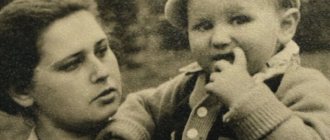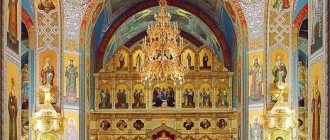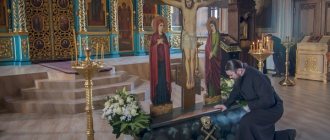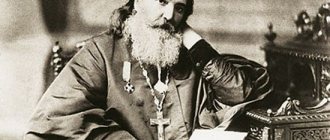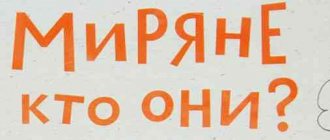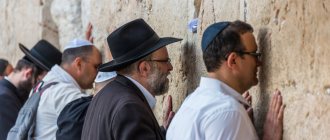Where did priests come from?
At all times, in all religions, there were people who were called “clergymen” in Soviet textbooks. In fact, they could be called differently, but the main thing was that these people played the role of intermediaries between a person and the spiritual forces that he worshiped. “Servants of the cult” prayed to these forces and made sacrifices to them. Although the priesthood existed (and exists) in most religious systems, the spiritual forces with which they deal are different. Therefore, it is very important to know to whom the sacrifice is made, to whom exactly this or that people worships.
In this regard, the Orthodox clergy has no connection with pagan priests, shamans, etc. They recognize their kinship with the priesthood of the Old Testament Israel, because the priests who, together with the prophet Moses, led the Jews to the Promised Land, worshiped the same God who is worshiped and Christians to the God of the Bible.
The priesthood of the Old Testament appeared almost 1500 years before Christ, when the Jews emerged from slavery in Egypt into the Promised Land. Then, on Mount Sinai, God gave Moses the famous Ten Commandments and many other laws that determined the religious and civil life of Israel. A separate chapter dealt with the place where the Israelites were supposed to make sacrifices to God, as well as the people who had the right to do this. This is how the tabernacle first appeared - a camp temple where the tablets of the Covenant were kept (two stone tablets on which the Ten Commandments were carved by God), and the ministers of the tabernacle. Later, following the model of this tabernacle, King Solomon built a huge temple in Jerusalem. All Israelis participated in the service, but only the priests could perform it. Moreover, just like the New Testament priesthood, the Old Testament priesthood was structured hierarchically, but it also had a significant difference - it was hereditary. For Orthodox Christians, the connection with the priesthood of the Old Testament is living and immediate. In Orthodox churches you can see icons of Old Testament high priests and priests. For example, children are still baptized with the name of the Old Testament priest Zechariah (Father John the Baptist).
The New Testament priesthood comes into being as a result of the coming of Jesus Christ into the world. New Testament priests serve the same biblical God. However, the way and meaning of their ministry changed. If in the Old Testament all sacrifices were tied to a specific place: they could only be offered in the Jerusalem Temple, then the New Testament sacrifice to God ceased to be associated with geography. The nature and essence of the sacrifice changed. In all religions, at all times, among all peoples, a person makes a sacrifice to the gods and their subsequent response to it is expected. In Christianity, on the contrary, God sacrifices Himself for people, literally sacrifices Himself on the Cross. Having made this sacrifice, the Lord awaits a response from man... It is with Golgotha that the ministry of the New Testament priesthood is connected. During the main Christian service - the Liturgy - through the prayer of believers with a priest at the head, Christ Himself makes a sacrifice, offers Himself. Then Christians unite with the Savior, partaking of His Body and Blood.
The biblical book entitled “The Acts of the Apostles” gives an idea of how the Church grew and developed in the first thirty years of its existence, how its three-tier hierarchical structure gradually took shape, which we see to this day. The first whom Christ blessed for the New Testament priestly service were His twelve closest disciples. In another way they are called apostles. From Greek this word is translated as “messenger”, or “envoy on a special mission.” This mission consisted of three things: priesthood, teaching and governance of the Church.
At first, the apostles did everything themselves - baptized, preached, dealt with a variety of economic issues, collecting and distributing donations, etc. But the number of believers quickly increased. Therefore, it was decided that economic and material issues would henceforth be dealt with by specially selected representatives of the community, so that the apostles would have enough time to fulfill their direct mission - performing divine services and preaching the Risen Christ. Seven people were elected who became the first deacons of the Christian Church (from the Greek diaconos - minister). A deacon is the first hierarchical level of the priesthood.
When the number of believers already reached thousands, twelve people were physically unable to cope with either the sermon or the sacred rites. In large cities, the apostles began to ordain people on whom they actually entrusted their functions: priesthood, teaching and administration. These people were called bishops (from the Greek - episcopos - overseer, overseer). The only difference between the bishops and the first twelve apostles was that the bishop had the power to officiate, teach and govern exclusively on the territory of his diocese (from the Greek eparchia - region, possession). And this principle has been preserved to this day.
Soon the bishops also needed helpers. The number of believers grew, and the bishops of large cities were physically unable to cope with the load that fell on them. Every day they had to perform divine services, baptize or perform funerals - and at the same time in different places. Therefore, bishops began to appoint priests to serve. They had the same power as bishops, with one exception - priests could not ordain people and performed their ministry only with the blessing of the bishop. Deacons, in turn, assisted both priests and bishops in serving, but they did not have the right to perform the Sacraments. In the Ancient Church, deacons played a huge role as the closest assistants and confidants of bishops, but gradually in the Orthodox Church their importance was reduced only to helping priests during divine services. After some time, a tradition developed that only those people who were first ordained to the diaconate became priests.
Priests are also called shepherds. This word does not indicate that all other Christians are a flock of silent sheep. A pastor is a measure of responsibility before God for every person a priest meets in his life. And the power of the priest always borders on this responsibility. Therefore, it is to the clergy, first of all, that the words of Christ are addressed: “To whom much is given, much will be required.”
What do the names of church ministers mean?
In the church environment you can hear a variety of appeals to church servants. The main character of any worship service is the priest. This is the person who is in the altar and performs all the rites of the service.
About the rules of behavior in the temple:
- Rules for visiting the temple
- Sacrament of Confession: rules
- Is it possible to receive communion without confession?
Important! Only a man who has undergone special training and ordained by the ruling bishop can become a priest.
The word “priest” in the liturgical sense corresponds to the synonym “priest.” Only ordained priests have the right to perform the Sacraments of the church, according to a certain order. In official documents of the Orthodox Church the word “priest” is also used to designate a particular priest.
Among the laity and ordinary parishioners of churches, you can often hear the address “father” in relation to one or another priest. This is an everyday, simpler meaning; it indicates a relationship with parishioners as spiritual children.
If we open the Bible, namely the Acts or Epistles of the Apostles, we will see that very often they used the address “My children” to the people. Since Biblical times, the love of the apostles for their disciples and the believing people was comparable to fatherly love. Also now, parishioners of churches receive instructions from their priests in the spirit of fatherly love, which is why the word “father” has come into use.
Father is a popular address to a married priest
What is apostolic succession?
One of the four essential properties of the Church, without which it cannot exist, is apostolate. This property essentially means that the Church always remains internally identical to the Church that it was under the apostles. However, this identity is determined by a number of very important external and internal characteristics, one of them is apostolic succession.
The priesthood is not inherited: priests are not born, but become. The acquisition of the grace of the priesthood occurs in the Church Sacrament. During this Sacrament, the bishop places his hands on the candidate’s head (hence the name of the rite - Ordination) and reads special prayers, thus becoming, as it were, the “father” of the newly ordained priest. If we trace the “family tree” of such ordinations into the depths of the past, we will discover why we are talking about apostolic succession. The fact is that, having reached the beginning of this chain of ordination, we discover an amazing fact: each ordained clergyman has one “ancestor”. This “ancestor” will be one of the twelve apostles of Christ.
Apostolic succession is one of the conditions that the Church is grace-filled, that the Sacraments are actually performed in it, which means that it fulfills its purpose - to lead people to salvation. However, apostolic succession is not limited to the unbroken chain of ordinations itself. Another condition is also necessary: the Church must preserve the doctrine that it received from the apostles (and the apostles from Christ Himself). Without this, no genuine apostolic succession exists.
The priest is a mediator between God and people
Priesthood - people chosen to serve the Eucharist and shepherd - care, spiritual nourishment of believers. The Lord first chose 12 apostles, and then 70 more, giving them the power to forgive sins and perform the most important sacred rites (which became known as the Sacraments). The priest in the Sacraments acts not by his own power, but by the grace of the Holy Spirit, given by the Lord after His Resurrection (John 20:22-23) to the apostles, transmitted from them to the bishops, and from the bishops to the priests in the Sacrament of Ordination (from the Greek Heirotonia - ordination) .
The very principle of the structure of the New Testament Church is hierarchical: both Christ is the head of the Church, and the priest is the head of the Christian community. The priest for the flock is the image of Christ. Christ is the shepherd; He commanded the Apostle Peter: “...feed My sheep” (John 21:17). Shepherding sheep means continuing the work of Christ on earth and leading people to salvation. The Orthodox Church teaches that there is no salvation outside the Church, but salvation can be achieved by loving and fulfilling the commandments of God and participating in the Sacraments of the Church, in which the Lord Himself is present, giving His help. And the helper and mediator of God in all the Sacraments of the Church, according to the commandment of God, is the priest. And therefore his service is sacred.
Priesthood and marriage
As the Church expanded, as people appeared who preferred monastic life to family life, different types of Christian life began to take shape. A division of the clergy into “white” and “black” appeared. Married priests are conventionally called “white,” and monastics are called “black.” In the first centuries of the Church's existence, all clergy (even bishops) could have families, but by the end of the first millennium, West and East diverged on this issue. In the West, mandatory celibacy was introduced, that is, celibacy of the priesthood. In the East, on the contrary, non-monastic priests were required to marry before ordination. However, before performing the Sacrament of Ordination, the future priest takes off his wedding ring and places it on the throne as a sign that his life now belongs only to God. That is why, according to church canons (rules), a person who has become a priest, being unmarried, does not have the right to marry after being ordained. Consequently, marriages of clergy are of particular importance for the Church.
The fact is that in his ministry, in his life, a priest must be the image of Christ, demonstrate the gospel ideal. The Gospel contains two maxims of Christian life - virginity for the sake of Christ and a family where spouses remain faithful to each other all their lives. Understanding human weaknesses, the Church makes leniency for the laity and blesses, in exceptional cases, up to three marriages. However, from married priests it fully requires the embodiment of the Gospel ideal of family in life. Following precisely the evangelical ideal, the Church does not elevate second-married people to the priesthood, but requires a priest who is divorced to remain celibate for the rest of his life.
What is the difference between a priest and a priest?
As for the concept of “pop,” in modern church practice it has some disdainful and even offensive connotations. Nowadays it is not customary to call the priesthood priests, and if they do, it is more in a negative way.
Interesting! During the years of Soviet power, when there was severe oppression of the church, all clergymen in a row were called priests. It was then that this word acquired a special negative meaning, comparable to the enemy of the people.
But back in the middle of the 18th century, the term “pop” was in common use and did not have any bad meaning. Basically only lay priests were called priests, not monastics. This word is attributed to the modern Greek language, where there is the term “papas”. This is where the name of the Catholic priest “pope” comes from. The term “priest” is also derived - this is the wife of a lay priest. Priests are especially often called priests among the Russian brethren on Mount Athos.
Read about famous Orthodox priests:
- Father Artemy Vladimirov
- Father Roman Matyushin
- Elder Seraphim Tyapochkin
In order to avoid getting into an awkward position, it is worth remembering that now the term “pop” has practically disappeared from the vocabulary of believers. When addressing a priest, you can say “Father Vladimir”, or simply “Father”. It is customary to address the priest’s wife with the prefix “Mother.”
For a believer, it does not matter much what words he uses to address the clergyman. However, the traditions and practice of church life develop certain forms of communication that it is advisable to know.
What should a real priest be like?
How to contact priests
Within each of the three hierarchical levels there is its own hierarchy. The Sacrament of the Priesthood is performed only when the candidate is elevated to the next of the three levels. As for the hierarchy of titles within these levels, in ancient times they were associated with special church obediences, and now - with administrative power, special merits, or simply the length of service to the Church.
The word "priest" has several Greek synonyms.
For the white priesthood:
- Priest (priest; from Greek hierуs - sacred).
- Presbyter (from Greek presbyteros, literally – elder)
- Protopresbyter (first elder)
- Archpriest (first priest)
For the black priesthood:
- Hieromonk (monk in the rank of priest)
- Hegumen (from the Greek hegumenos, literally - going ahead, leader, commander), in ancient times (and in the modern Greek Church) only the abbot of the monastery; in modern practice of the Russian Church, the title can be given to simple hieromonks for special merits and after a certain period of time service to the Church.
- Archimandrite (from the Greek archon - head, elder and mandra - sheepfold; literally - elder over the sheepfold), that is, the elder over the monastery. The word “mandra” was used to describe monasteries in Greece. In ancient times, only the abbot of one of the largest monasteries (in the modern Church of Constantinople and Greece this practice is preserved, however, an archimandrite can be both an employee of the Patriarchate and an assistant to the bishop). In modern practice of the Russian Church, the title can be given to the abbot of any monastery and even simply to abbots for special merits and after a certain period of service to the Church.
The words pop and protopop stand apart. In Rus', these words did not have any negative meaning. Apparently, they come from the Greek “pappas”, which means “daddy”, “father”. This word (due to its prevalence among the Western Slavs) probably came into the Russian language from Old High German: pfaffo - priest. In all ancient Russian liturgical and other books, the name “priest” is constantly found as a synonym for the words “priest, priest and presbyter.” Protopop is the same as protopresbyter or archpriest.
As for appeals to priests, they exist official and unofficial. Unofficially, priests and deacons are usually called fathers: “Father George”, “Father Nikolai”, etc. Or simply “father”. On official occasions, the deacon is called “Your Reverence,” the presbyter “Your Reverence,” the protopresbyter “Your Reverence.” When addressing a bishop, they say “Vladyka” (Vladyka George, Vladyka Nikolai). In the Russian Orthodox Church, when formally addressing a bishop, he is called “Your Eminence,” while archbishops and metropolitans are called “Your Eminence.” The Patriarch is always addressed: “Your Holiness.” All these appeals relate not to the person’s personality, but to his ministry.
Is it possible to call a priest a priest?
The original meaning of the word “pop” does not carry a negative meaning. However, before addressing a priest this way, it is worth finding out whether such treatment is acceptable for him or not. What may be an ordinary professional title for one person may be an indicator of your negative attitude towards it for another.
Issues of external pious behavior often concern parishioners of many churches. How to address clergy correctly, how to distinguish them from each other, what to say when meeting? These seemingly little things can confuse an unprepared person and make him worry. Let's try to figure out whether there is a difference in the concepts of “priest”, “priest” and “priest”?
The priest is the main character of any worship service.
Confessor - who is this?
People who are not sufficiently familiar with the life of the Orthodox Church, but have Orthodox acquaintances, can often hear the word “spiritual father” in their speech. For example, “my confessor said...”, “my confessor advised me...”, etc. Non-church people, hearing this, may think that there is another special level of priesthood in the Church. This is wrong. The confessor is the same priest or bishop (which happens much less frequently due to their enormous administrative burden). The only peculiarity of a confessor lies in the nature of the relationship between him and a specific parishioner of an Orthodox church. For example, for confession a person can approach any priest in any church.
However, if we are talking not only about performing the Sacrament of Confession (forgiveness of sins on behalf of God), but also about receiving advice, about additional conversation, help in solving various issues and difficulties in the life of a Christian, the parishioner naturally strives to find a priest with whom in the future his church life will be connected. If a priest, in turn, delves into and knows all the problems of this person and helps resolve them from a spiritual point of view, shares with him the spiritual experience of life in the Church, then he is called a spiritual father or confessor, and the parishioner, respectively, a spiritual son or spiritual daughter . The very name “spiritual father” is due to the fact that it is he who helps a person to be spiritually born, that is, to experience for himself what real spiritual life is and how to live it.
The presence of a confessor is not a mandatory condition for a person to remain in the Church. However, without a confessor it is very difficult to adopt the living experience of spiritual life. The influence of the confessor is based solely on his authority with the spiritual son (or daughter) and does not have any formal consequences for the salvation of a person.
magazine "Foma", 07.16.05
Anti-religious propaganda
The greatest blow to the word “priests” was dealt by the Soviet ideological campaign. Anti-religious propaganda was not only not prohibited, but was also encouraged. The Constitution of 1936 prohibited any missionary activity.
The image of the clergyman was ridiculed in newspapers, books, and on the radio. Almost everywhere the clergyman was portrayed as a greedy, immoral, repulsive character. And they called him exclusively “pop”. The Soviet leadership understood perfectly well who the target audience was: workers and peasants were unlikely to call priests “priests.”
Many documentary evidence of the persecution of the Orthodox Church has been preserved: these are grotesque propaganda caricatures, caustic, cynical lampoons, speeches by the “Union of Godless” and so on. The consequences of militant atheism are still evident today.
Some modern followers of religionists cross the line of criticism of religion and are incapable of constructive discussion. They use the word "pop" as an insult.
The priest is a witness in the Sacrament of Confession
Without a priest, the Sacrament of Confession is impossible. The priest is endowed by God with the right to announce the forgiveness of sins in the name of God. The Lord Jesus Christ said to the apostles: “Whatever you bind on earth will be bound in heaven, and whatever you loose on earth will be loosed in heaven” (Matthew 18:18). This power to “knit and loosen” passed, as the Church believes, from the apostles to their successors - bishops and priests. However, confession itself is brought not to the priest, but to Christ, and the priest here is only a “witness,” as stated in the rite of the Sacrament. Why do you need a witness when you can confess to God Himself? The Church, when establishing confession before a priest, took into account the subjective factor: many are not ashamed of God, because they do not see Him, and it is a shame to confess before a person, but this is a saving shame that helps to overcome sin. In addition, as Archpriest Sergius Pravdolyubov explains, “the priest is a spiritual mentor who helps to find the right path to overcome sin. He is called not only to become a witness of repentance, but also to help a person with spiritual advice and support him (many come with great sorrows). No one demands submission from the laity - this is free communication based on trust in the priest, a mutual creative process. Our task is to help you choose the right solution. I always encourage my parishioners to feel free to tell me that they were unable to follow some of my advice. Perhaps I was mistaken, I did not appreciate the strength of this man.”
Another ministry of a priest is preaching. Preaching, carrying the Good News of salvation is also a commandment of Christ, a direct continuation of his work, therefore this ministry is sacred.
A priest cannot exist without the people
In the Old Testament Church, the participation of the people in worship was reduced to passive presence. In the Christian Church, the priesthood is inextricably linked with the people of God and one cannot exist without the other: just as a community cannot be a Church without a priest, so a priest cannot be one without a community. The priest is not the sole performer of the Sacraments: all the Sacraments are performed by him with the participation of the people, together with the people. It happens that the priest is forced to perform the service alone, without parishioners. And, although the rite of the liturgy does not provide for such situations and it is assumed that a meeting of people participates in the service, yet in this case the priest is not alone, because the angels, as well as the saints and the departed, make a bloodless sacrifice with him.
About priests and priesthood on Pravmir:
- Why are priests needed?
- About priests|Priests' answers to questions
- How to become a priest, or the parachute rule
- Myths about priests
- Archbishop Mark of Yegoryevsk: A reasonable priest would not drive a Lexus!
- Why does a priest get tired?
- Priests are people too
- Should a priest work in a secular job so as not to depend on the parish?
- Priests and monks - veterans of the Great Patriotic War
- The Marriage of a Priest, or the Battle for the Ring
- Confession of a Prison Priest
- The priest's answer to the philosopher
- Priest, elder, confessor...
- Diary of a Country Priest
- The priest must maintain a high level of public rhetoric
- Priest Friend: Why not?
- What is it like to be a “former” priest?
- The priest makes cynical jokes, gets sick or drinks. What's wrong with him?
- Archpriest Oleg Teor: The army needs a priest like a father
- Priests of a big city. Father Anthony Lakirev
- Confessions of a Bad Priest
Who can become a priest?
In Ancient Israel, only persons belonging to the tribe of Levi by birth could become priests: the priesthood was inaccessible to everyone else. The Levites were initiates, chosen to serve God - they alone had the right to make sacrifices and offer prayers. The priesthood of the times of the New Testament has a new meaning: the Old Testament sacrifices, as the Apostle Paul says, could not deliver humanity from slavery to sin: “It is impossible for the blood of bulls and goats to take away sins...” (Heb. 10: 4-11). Therefore, Christ sacrificed Himself, becoming both Priest and Victim. Not belonging by birth to the tribe of Levi, He became the one true “High Priest forever, according to the order of Melchizedek” (Ps. 109:4). Melchizedek, who once met Abraham, brought bread and wine and blessed him (Heb. 7:3), was an Old Testament prototype of Christ. Having given His Body to death and shed His Blood for people, having taught this Body and this Blood to the faithful in the Sacrament of the Eucharist under the guise of bread and wine, having created His Church, which became the New Israel, Christ abolished the Old Testament Church with its sacrifices and the Levitical priesthood, removed the veil, which separated the Holy of Holies from the people, destroyed the insurmountable wall between sacred Leviticism and the profane people.
A priest of the Orthodox Church, explains Archpriest Sergius Pravdolyubov, “can become any pious, virtuous person who fulfills all the commandments and rules of the church, has sufficient training, was married in his first and only marriage to a girl of the Orthodox faith, is not disabled with a physical obstacle to using his hands and feet (otherwise he will not be able to perform the liturgy, carry the Chalice with the Holy Gifts) and is mentally sound.”
The priest is a symbol of Christ
The most important Sacrament of the Church is the Eucharist. The priest celebrating the Eucharist symbolizes Christ. Therefore, the liturgy cannot be celebrated without a priest. Archpriest Sergiy Pravdolyubov, rector of the Church of the Life-Giving Trinity in Troitsky-Golenishchevo (Moscow), master of theology, explains: “The priest, standing before the Throne, repeats the words of the Lord Himself at the Last Supper: “Take, eat, this is My Body...” And in the prayer for He pronounces the following words from the Cherubim song: “You are the One who offers and the One who is offered, and the One who accepts this Sacrifice, and the One Who is distributed to all believers - Christ our God...” The priest performs a sacred act with his own hands, repeating everything that Christ Himself did . And he does not repeat these actions and does not reproduce, that is, he does not “imitate”, but, figuratively speaking, “pierces time” and is completely inexplicable for the usual picture of space-time connections - his actions coincide with the actions of the Lord Himself, and his words - with the words of the Lord! That is why the liturgy is called Divine. It was served once by the Lord Himself in the time and space of the Zion Upper Room, but outside of time and space, in the abiding Divine Eternity. This is the paradox of the doctrine of the Priesthood and the Eucharist. Orthodox theologians insist on this, and this is how the Church believes.
A priest cannot be replaced by a layman, not only “due to human ignorance,” as it is written in the ancient Slavic books, let the layman be an academician, no one gave him the power to do something that one cannot dare to do without receiving the gift of the grace of the Holy Spirit through ordination, coming from the apostles themselves and the apostolic men.”
The Orthodox Church attaches exceptional importance to the priesthood. The Monk Silouan of Athos wrote about the high dignity of the priesthood: “Priests carry within themselves such great grace that if people could see the glory of this grace, the whole world would be amazed at it, but the Lord hid it so that His servants would not become proud, but would be saved in humility ... A great person is a priest, a servant at the Throne of God. Whoever insults him insults the Holy Spirit living in him..."


